Leather items are prized for their durability and classic aesthetic; however, they are also susceptible to developing musty odors. This unpleasant smell often arises when leather is exposed to excess moisture or stored improperly in damp or poorly ventilated environments.

Moreover, leather is a porous material, which means it can easily absorb various odors, including mustiness, if not maintained regularly. Therefore, it’s crucial to address any unwanted smells promptly to prevent any long-term damage or degradation of the material.
When considering how to tackle this issue, one might ask, “how do you get musty smell out of leather?” The cleaning process involves several steps: first, it is important to thoroughly air out the leather in a dry, open environment.
Following this, employing odor absorbers like baking soda or activated charcoal can effectively neutralize lingering smells. Finally, a gentle cleaning followed by proper conditioning will help restore the leather’s integrity and appearance.
Materials Needed
To effectively remove the musty smell from leather, you’ll need to gather some essential materials for cleaning.
Soft Cloths or Microfiber Cloths are crucial for wiping and cleaning the leather without leaving scratches. These cloths provide a gentle touch, ensuring that the leather’s surface remains unharmed.
Baking Soda or Activated Charcoal serve as natural odor absorbers, perfect for neutralizing the musty smells that have settled into the leather fibers. For a more thorough cleaning, adding
White Vinegar (Optional) can be beneficial, as it acts as a mild cleaning solution capable of breaking down stubborn odors. A dedicated
Leather Cleaner is recommended to cleanse the leather without causing any damage; this product is specifically formulated to handle the unique needs of leather materials. Following the cleaning process, applying a
Leather Conditioner is essential to restore the leather’s moisture, softness, and suppleness. Lastly, for the odor absorption phase, a
Large Plastic Bag or Pillowcase is required to enclose the leather with either baking soda or activated charcoal, trapping and neutralizing the unpleasant odors. Optionally,
Dryer Sheets (Optional) can be included for additional odor neutralization, providing a fresh scent as a finishing touch.
Airing Out the Leather
Why Airing Out is Important
Airing out leather is a crucial step in eliminating musty odors that often develop over time due to prolonged storage or exposure to moisture. Fresh air enables the musty particles to dissipate, reducing the intensity of the unpleasant smell in the leather. This natural method leverages the flow of air to gradually lift away trapped odors, providing a safer alternative to harsh chemical treatments that may potentially damage the leather’s surface.

Choosing the Right Location
Select a well-ventilated, dry area for your leather item to promote effective airing out. An ideal location would be a space that facilitates ample air circulation while being shielded from direct sunlight, which can cause the leather to fade or dry out excessively.
A shady porch, a breezy room, or an open garage may serve as suitable options. It’s important to place the leather on a clean surface to avoid dirt and stains or to hang it to allow air to circulate freely around all sides. This ensures an even distribution of air exposure and optimizes the airing out process.
Time Required
For effective odor elimination, leaving your leather item to air out for a minimum of 24-48 hours is recommended. The specific duration may vary depending on the intensity of the odor; worse odors will require longer time frames to adequately dissipate. Regular checks throughout the process can help you determine if more time is necessary.
Using a Fan (Optional)
If you wish to accelerate the airing-out procedure, consider placing a fan near the leather. The increased air circulation can help speed up the dissipation of musty smells. Position the fan to direct a gentle breeze across the leather’s surface, ensuring that the airflow evenly reaches all areas. This additional step can be especially beneficial in environments with limited natural airflow.
How Do You Get Musty Smell out Of Leather: Using Odor Absorbers
Baking Soda Method
Step-by-Step Guide:
- Prepare the Leather Item: First, ensure that the leather item is clean and dry. Then, gently wipe it down with a soft, dry cloth to remove any surface dirt or dust.
- Using a Breathable Cloth Bag: To prevent baking soda from directly contacting the leather, place the leather item inside a breathable cloth bag. This step is crucial to protect the leather surface from potential abrasions or residue left by the baking soda.
- Enclose in a Larger Bag: Place the leather item (inside its cloth bag) into a large plastic bag or pillowcase. If using a plastic bag, opt for one with an airtight seal to maximize the effectiveness of odor absorption.
- Apply Baking Soda: Sprinkle a generous amount around the leather item inside the larger bag. Although it shouldn’t touch the leather directly, ensure enough is used to adequately absorb the odors.
- Seal and Leave: Seal the bag securely and stay undisturbed for 24-48 hours. The baking soda will absorb the musty smells during this period. Monitor the process, and if the odor persists, consider repeating the method.
Activated Charcoal Method
- Prepare Charcoal Packets: Use activated charcoal packets or place loose charcoal pieces in a small, breathable bag.
- Bag Placement: Position the charcoal packets or bags alongside the leather item within a large plastic bag, ensuring there is space for air circulation.
- Seal the Bag: Secure the plastic bag, ensuring it’s completely sealed to prevent air escape, which aids in effectively trapping odors.
- Odor Neutralization: Activated charcoal traps airborne particles, effectively neutralizing persistent smells. Keep the bag sealed for several days—ideally up to a week if the odor is especially intense.

Dryer Sheets (Optional)
- Placement of Dryer Sheets: Insert unscented dryer sheets inside various parts of the leather item, such as pockets or interior compartments. This adds an additional layer of odor control.
- Replacing Sheets: Every couple of days, replace the dryer sheets until the musty smell has completely subsided.
By following these methods, you can effectively eliminate unwanted musty odors from your leather items, ensuring they remain fresh and ready for use.
How Do You Get Musty Smell out Of Leather: Cleaning the Leather
Using a Mild Leather Cleaner
Using a mild leather cleaner is highly effective for removing surface dirt and oils that may contribute to the musty smell. This type of cleaner is specially formulated to gently cleanse leather without stripping away its natural oils.
Step-by-Step Instructions:
- Read the Instructions: Read the instructions on the cleaner’s packaging to learn the recommended usage.
- Prepare a Soft Cloth: Dampen a soft, lint-free cloth with the leather cleaner. Avoid soaking the cloth; a small amount is sufficient for effective cleaning.
- Spot Test the Cleaner: Conduct a spot test on a hidden area to ensure the cleaner is safe for your leather. Apply the cleaner to this spot and wait for any adverse reactions.
- Clean in Circular Motions: Once confirmed safe, gently wipe the leather using the cloth in small circular motions. Focus on areas with visible dirt or heavier oil buildup.
- Avoid Excess Moisture: Ensure the cloth is not overly wet, as excess moisture can damage the leather.

White Vinegar Solution (Optional)
White vinegar is known for its natural deodorizing properties, making it an excellent solution for tackling musty smells in leather.
Step-by-Step Instructions:
- Prepare the Solution: Mix equal parts of white vinegar and distilled water in a container.
- Dampen a Soft Cloth: Immerse a soft cloth in the solution, then wring out any excess liquid to avoid soaking the leather.
- Wipe the Leather: Gently wipe down the leather with the damp cloth, allowing the vinegar’s properties to neutralize odors. Be careful not to over-saturate.
- Dry with a Separate Cloth: Use another dry cloth to blot and remove excess moisture.
Letting the Leather Dry
After cleaning, it’s crucial to allow the leather to dry naturally. Place the leather in a well-ventilated area, away from direct sunlight or heat sources, which can cause the material to fade or crack. Ensure the leather is completely dry before proceeding to the conditioning stage, as applying conditioner to damp leather can lead to mildew or further odor development. Patience at this stage ensures the leather remains in optimal condition.
Conditioning the Leather
Why Conditioning is Important
Conditioning leather is a crucial step in maintaining its durability and appearance. The cleaning process, while effective in removing dirt and odors, can sometimes strip the leather of its natural oils, leaving it dry and susceptible to cracking.
To prevent this, using a suitable leather conditioner replenishes these essential oils and keeps the leather supple and soft. When selecting a conditioner, ensure it is compatible with the type of leather you’re treating. An inappropriate product may alter the texture or appearance of the leather.
Applying Leather Conditioner
Step-by-Step Instructions:
- Choose the Right Cloth: Select a soft, lint-free cloth for application to prevent scratching the leather surface.
- Apply a Small Amount: Pour a small amount of leather conditioner onto the cloth, ensuring it is well-distributed but not soaked.
- Massage into Leather: Gently massage the conditioner into the leather using small circular motions. This technique helps evenly distribute the product and improves absorption. Pay extra attention to areas exposed to moisture or frequent use, as they tend to dry out more quickly.
Letting the Leather Absorb
After application, allow the conditioner to fully absorb into the leather. This process can take several hours, so it is best to leave the item in a cool, dry place during this time.
Once absorbed, use a clean, dry cloth to gently buff the leather surface, removing any excess conditioner and enhancing the leather’s natural sheen. Regular conditioning ensures your leather remains in prime condition, enhancing its longevity and functionality.

Conclusion
Promptly addressing musty smells in leather is essential to prevent long-term damage. These odors can signify deep-seated issues that, if neglected, might compromise the leather’s integrity. You can effectively tackle this common issue by systematically following the cleaning and deodorizing steps outlined, such as airing out the leather, using odor absorbers like baking soda or activated charcoal, and rigorously cleaning and conditioning.
If you ever wonder, “how do you get musty smell out of leather,” remember that maintaining proper storage and care is equally critical. You can significantly reduce the risk of future odor development by keeping leather items in a well-ventilated space, away from excessive moisture, and ensuring regular cleaning and conditioning.
Employing these strategies ensures that your leather possessions remain fresh and functional and they look their best for years to come, preserving their value and enhancing your enjoyment.

